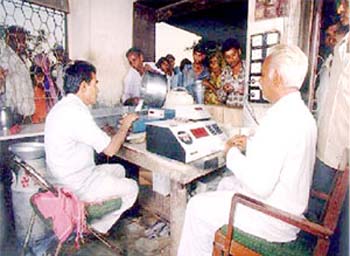|
Introduction
 |
DISK is an initiative aimed at helping the dairy farmers with timely messages and educating them on the care for their milch cattle and enhance the production of quality milk. It also aims at assisting the dairy unions in effectively scheduling and organizing the veterinary, artificial insemination, cattle feed and other related services. |
Application Context
The co-operative movement began at Amul Dairy in Gujarat and is now replicated in 70,000 villages in about 200 districts of India. The number of farmers organised into village milk producers' co-operative societies is now over one million, and the daily procurement of milk by the co-operatives is 13 million litres per day.
Following the repeal of quantitative restrictions on food imports by the Government of India under a WTO agreement, the Indian dairy sector faces a strong challenge from the large organised dairies in the developed world. To meet this challenge, the co-operative dairy sector has to further improve the production, collection, processing and marketing of milk and milk products.
New Approach
A new initiative taken by National
Dairy Development Board (NDDB) has led to
more efficient collection of milk and higher profits for producers.
Each farmer is given a plastic card as identification. At the counter he/she drops the card into a box, which reads the card electronically and transmits the identification number to a personal computer. The milk is then emptied into a steel trough kept over a weigh bridge. Instantly, the weight of the milk is displayed to the farmer and communicated to a PC. Then, an operator sitting by the side of the trough takes a 5 ml. sample of milk and holds it up to a tube connected to an electronic fat testing machine. The fat content is displayed to the farmer and is communicated to the PC.
The computer calculates the amount due to the farmer on the basis of a rate chart that indicates the price for milk with different levels of fat content. The total value of the milk is then printed out on a payment slip and given to the farmer, who can collect the payment at an adjoining window.
In many centres this entire transaction takes no more than 30 seconds. This application is used in approximately 2,500 rural locations, exposing half a million people daily to the benefits of information technology.
The benefits of above system has been extended by introduction of a new software - DISK. It has two major components - an application with enhanced database and reporting running at the society level and connectivity to a Dairy Portal serving transactional and information needs of all members and staff at various levels in the district co-operative structure.
This DISK database includes a complete history of all milch cattle owned by the farmers. The basic details of breed and a history of disease, inoculations, artificial insemination and pregnancy are maintained in the system. Longitudinal data on milk production by individual farmers is also available in the database. Decision support systems have been developed to forecast milk collection, and provide feedback to the farmers.
Through the Dairy Kiosk farmers may place orders for a variety of goods and services offered by different agencies in the co-operative sector, and seek information on a variety of subjects of interest (e.g., best practices in breeding and rearing milch cattle, schedule of services provided by the co-operative, government and other private sector agencies). The computer-printed receipts that farmers receive each time they deliver milk provide an additional means for co-ops to communicate with their farmers.
Benefits and Costs
- The milk vending system costs around $2,000 per centre.
- Payments are based on a reliable and transparent measurement of fat content and weight.
- Farmers receive immediate payment for their milk
- Queues at the milk collection centres are short, saving farmers considerable time.
|